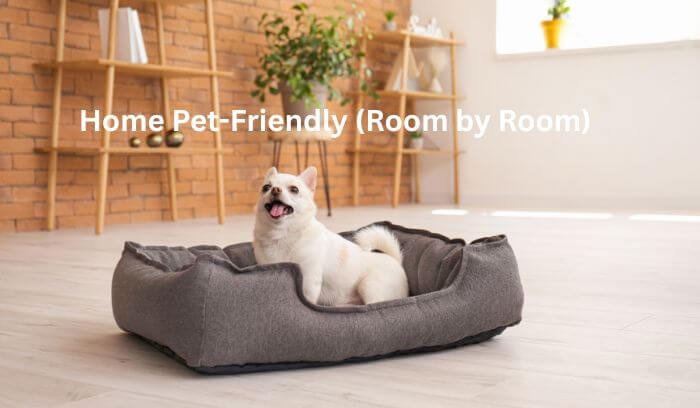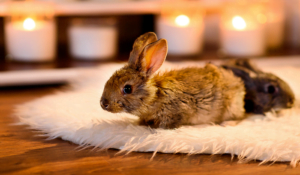Pet-friendly home Safety is a top priority when it comes to our homes. But for our pets, the concept of safety can be worlds apart. What is harmless to us can be quite dangerous to companion animals. Pet-proofing is vital to creating your home as a haven, not a hazard. Beneath are steps to pet-proofing your home. Here we will discuss how to make your pet-friendly home.

STEP 1—UNDERSTANDING YOUR PET’S WORLD
The initial process is to monitor your pet’s behavior and routine to predict possible danger. Pets make use of their senses to find out hidden threats. To illustrate, Anne Senft, HSLC Board President, had a blind cat that depended on memory and sense of touch to get regarding. “We were given advice not to move any furniture because he would ‘map’ out the basement like a robot vacuum,” she shares. This experience points out the significance of stability in your pet’s environment.
Pet-friendly home prior to bringing a pet into the home or altering their environment, determine where curiosity and instinct can lead them astray. Take into consideration the underlying motivations of their behavior, such as their inborn urges to sniff, chew and explore, and body capabilities that allow them to climb and jump.
STEP 2—ROOM-BY-ROOM CHECKLIST Pet-friendly home
With awareness, investigate every room to do away with hazards and ensure safety.
1. Living Room: Keep cords and wires secure, place poisonous plants out of reach, and fasten heavy furniture to the wall to avoid tipping.
2. Kitchen: Keep food and cleaning products stored safely, cover counter tops and appliances, and keep crumbs and spills under control.
3. Bathroom: Keep towels and toilet paper out of reach, keep bathroom trash cans secure, and keep medications and cosmetics safely stored.
4. Bedrooms: Put together clothes and shoes, keep electrical cords and equipment, and restrict entry to closets and drawers.
STEP 3—IDENTIFY HIDDEN DANGERS Pet-friendly home
Hidden dangers are frequently overlooked spots that can be major hazards to your pet’s safety. These include:
• Electrical outlets
• Choking hazards
•Toxic substances
• Fall risks
STEP 4—ASSESS PET-SPECIFIC NEEDS Pet-friendly home
Take into account your pet’s character traits, like age, size, breed, and potential, to customize your pet-proofing plan. For a case in point:
• As mentioned earlier, blind animals need regular furniture placement to enable them to move around by memory and touch.
• Older animals require easy access to necessities such as food, water, litter, and preferred resting places to cater to their declining mobility and possible health complications.
• Puppies require secure living spaces, such as off-limit areas and locked-away harmful substances, which will serve to shield their curious nature and fast growth.
• Small pets need safe enclosures and covered electrical cords to avoid escape and electrical injury.
• Large pets require heavy-duty furniture and tied-down heavy items to avoid accidents and destruction.
• Medical pets can have adaptations made to support special health requirements, including easy-clean surfaces for pets with allergies.
STEP 5—CREATING A PET-FRIENDLY
• Marking pet areas for relaxation. Establish comfortable spaces where your pet can retreat for relaxation and calm. This minimizes stress and creates a sense of safety.
• Selecting easy-to-clean, durable surfaces. Pick easy-to-clean, durable surfaces. Wood, tile, waterproof furniture, and washable walls are simple to clean, creating a healthy and Pet-friendly home.
• Interacting with and supervising your pet. Use up quality time with your pet in play, exercise, and mental stimulation. This bond makes your pet joyful and healthy.
Keep in mind that pet-proofing is not merely eliminating hazards; it is also presenting an atmosphere that is well to well-being. Keep your furry friends safe and healthy today!
Pet-Proofing Your Pet-Friendly Home
Cats and dogs (especially kittens) can be incredibly curious. But there are things that you can do to pet-proof your house and protect your pets. Here’s how to protect your companion animal in your pet-friendly home:
KITCHENS/BATHROOMS
• Baby-proof latches to prevent little paws from opening up cabinets
• Store medications, cleaners, chemicals and laundry materials out of reach on high shelves.
• Store trash cans under a cover or in a latched cabinet.
• Inspect and block off any tiny holes, crevices or gaps within cabinets or behind washer/dryer equipment.
• Ensure your kitten has not climbed into the dryer prior to turning it on.
• Store foods out of reach (even if the food is not toxic, the packaging may be).
• Leave the toilet lid closed to avoid drowning or ingestion of toxic cleaning supplies.
LIVING/FAMILY ROOM
• Keep lamp, DVD player, television, stereo and phone dangling cords away from reach.
• Store children’s toys and games.
• Store knick-knacks until your kitten develops the coordination to avoid knocking them over.
• Inspect all those areas where your vacuum cleaner won’t go, but your puppy or kitten will, for hazardous items, such as string.
• Move common house plants that may be poisonous out of reach. Don’t forget hanging plants that can be jumped onto from the nearby facade.
• Make certain all heating/air vents have cover-ups.
• Put away all sewing and craft notions, in particular thread.
GARAGE
• Move chemicals to the rest shelves or to the back closed doors.
• Clean all antifreeze off the driveway and floor, as one sip can be fatal to animals.
• Slap on your car hood to make sure that your kitten (or any local cat) hasn’t crawled into the engine compartment for heat.
• Keep sharp tools and objects out of reach.
BEDROOMS
• Store laundry and shoes following closed doors (buttons and drawstrings can escalate to serious subjects if ingested).
• Have any medication, cosmetics or lotions off of reachable surfaces (such as the bedside table).
• Pull cords on electricity and phone wires out of reach of chewing.
• Watch so you don’t trap your kitten in closets or dresser drawers.
And watch for paws, noses and tails when closing doors behind you or pushing chairs. Hopefully, these steps pet-proof your home and keep your animals protected!
Final Thoughts Pet-friendly home
A pet-friendly home your house may be a danger zone for pets, and pet-proofing is the best way to ensure safety for both you and your furry friend.






